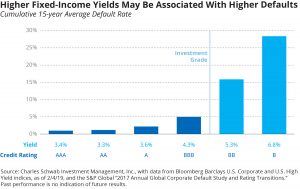Get more! Sign up for PLANSPONSOR newsletters.
Everyone Is Paying More Attention to Bond Funds These Days
In a changing interest rate environment, for right or wrong everyone pays more attention to bond funds. Combine that increased attention with the heightened volatility in the equity markets we’ve seen recently, and the focus on bond funds is even greater. Given that, it’s an important time for advisers and plan sponsors to remember what to look for when evaluating the funds and managers on the fixed-income side of a retirement plan’s investment menu. Here’s a short list of things to remember:
Yield isn’t free. Active bond managers are hired to beat their indexes. It’s a competitive environment, and, as a result, some managers find it hard to resist seeking a yield advantage over their benchmark. That of course indicates potential excesses in risk-taking. Some investors don’t see that, though. For them, choosing a higher-yielding bond fund can look like a no-brainer, like getting a head start in a race. But yield isn’t free. It comes with greater susceptibility to risk.
High-yield bonds act more like stocks. Higher-yielding bonds tend to outperform in up-markets and underperform in down-markets, just like equities. That means, instead of delivering a diversification benefit when fixed-income investors need it most, these positions can add to a portfolio’s equity-like risk and downside rather than reduce it. The potential double whammy of fixed income and equity falling in tandem is a dreadful outcome for portfolios, rather than fixed income providing stability against equity market turmoil.
Managers can resist selling out of bad positions. If the value of a high-yield bond drops, some managers will automatically be reluctant to sell. After all, yield is what you earn if the security matures. Therefore, some managers would prefer to ride out underperformance until maturity, seeking yield but taking on the heightened risk potential of default and permanent loss. Managers need the fortitude and risk-awareness to consider if the right—and safer—decision might be to sell in the present.
Lower-rated bonds introduce other risks. Adding in lower-rated bond positions to increase yield introduces other risks, from illiquidity to a higher likelihood of default. (See chart below). While defaults are rare, they still occur. And, in particularly challenging market environments, lower-rated companies can face pressures from all sides. There’s a parallel message here for portfolio allocation: At a time when equity risks are running high, that’s not when you want to be taking on more risk such as a higher likelihood of defaults.
Remember what bonds are for
You need bonds in a well-balanced portfolio. Just remember what they’re for. At Schwab, we use them for managing risk and diversification.
Plan sponsors and their advisers should have a clear objective and intended outcome for the bond funds in their plans. Make sure your choices are deliberate, and monitor your bond managers closely to confirm their strategies align with yours. If your objective is safety and diversification relative to equities, be wary of yield-seeking bond managers.
Some active bond managers seek higher yields as a core part of their ongoing process, but remember that a higher yield isn’t alpha—returns; it’s really beta—risk. A bond strategy that overemphasizes yield can concentrate risk rather than reduce it, thus compromising what the fixed-income component of a portfolio is intended to do. It’s like unbuckling your seatbelt the moment you step on the gas.
Fixed-income securities are subject to increased loss of principal during periods of rising interest rates. Fixed-income investments are subject to various other risks including changes in credit quality, market valuations, liquidity, prepayments, early redemption, corporate events, tax ramifications and other factors.
Brett Wander is chief investment officer (CIO), fixed income, Charles Schwab Investment Management, Inc. Jake Gilliam, is head client portfolio strategist, multi-asset strategies, Charles Schwab & Co., Inc.
Charles Schwab Investment Management (CSIM) is an affiliate of Charles Schwab & Co., Inc. (Schwab) and a subsidiary of The Charles Schwab Corporation. 0219-9RWB
This feature is to provide general information only, does not constitute legal or tax advice, and cannot be used or substituted for legal or tax advice. Any opinions of the author do not necessarily reflect the stance of Institutional Shareholder Services, Inc., or its affiliates.





